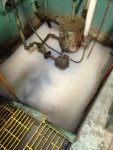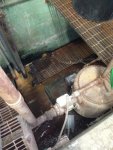If the pump motors are sealed then I'm not seeing the safety problem, we have all kinds of motors that are not just located by water but actually run underwater, think wells and sump pumps as well as lift stations, electrically they are no different, if there seals ever leak and the water is conductive enough then it would not be long for OCPD's to open, the main concern is since LTFMC (seal tight) is being used, make sure there is a good equipment grounding conductor also installed in the seal tight, make sure the connections are good and clean, dielectric grease is your best friend in keeping connections good when you have high moisture content that can cause connections to corrode, it is imperative to make sure you have a good ground fault path back to source, as long as the grounding path is good, the shock danger is just not there, as long as no one will try to work on the pump without lock out, tag out, and try out.
This is a very common installation that can be seen in many industrial installations, again I stress to not use the seal tight as a grounding path in an installation like this as it too can corrode at its connections and with out an internal EGC your fault path could not be depended upon.
Even the pressure switch or any other electrical equipment in and around this pit should be checked for grounding.



